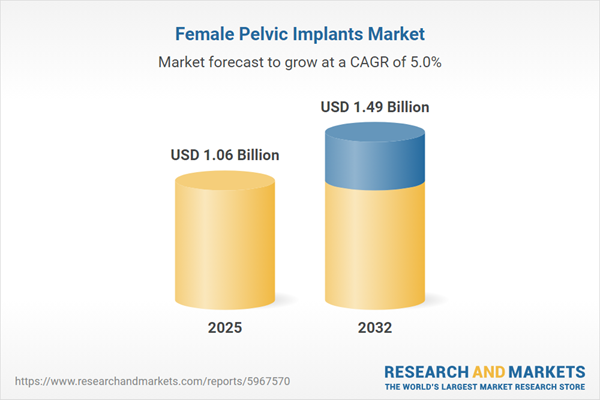Speak directly to the analyst to clarify any post sales queries you may have.
Senior executives face a rapidly evolving female pelvic implants market shaped by transformative innovation, changing compliance demands, and increasing collaboration pressures across the healthcare ecosystem. Success depends on operational flexibility, preparedness for regulatory change, and targeted strategy implementation.
Market Snapshot: Female Pelvic Implants Market Analysis
The female pelvic implants market reached USD 1.01 billion in 2024, with strong growth momentum forecast to drive value to USD 1.06 billion by 2025—reflecting a compound annual growth rate of 4.95%. Uptake of minimally invasive pelvic procedures and continued improvements in implant materials motivate purchasing across global markets, including North America, Europe, Asia Pacific, the Middle East, and Africa. As shifts in reimbursement guidelines and sourcing strategies impact procurement, regional adaptation and regulatory awareness are essential for stakeholders. Senior leaders must address the interplay of compliance, clinical protocols, and supply chains to maintain competitive resilience in this dynamic sector.
Scope & Segmentation of the Female Pelvic Implants Market
- Product Types: Dual-channel balloon, single-channel balloon, anterior mesh, posterior mesh, combination mesh, retropubic sling, transobturator sling, and mini sling devices expand clinical options for treating simple and complex pelvic conditions.
- Clinical Applications: Devices are utilised in managing neurogenic bladder dysfunction, pelvic organ prolapse (cystocele, rectocele, vaginal vault prolapse), and urinary incontinence, supporting precision in care pathways and targeting diverse patient populations.
- Material Innovations: Options include allograft, autologous, and xenograft tissues, as well as polyester, polyethylene, polypropylene, and polymer composites. These materials are chosen based on surgical requirements, patient safety, and compatibility.
- End Users: Academic hospitals, community hospitals, ambulatory surgical centers, and pelvic health clinics guide procurement strategies and device utilization according to institutional processes and patient needs.
- Distribution Channels: Direct sales, specialty distributors, OEM partners, and digital procurement platforms are instrumental in streamlining device access, improving fulfilment speed, and reacting to regional market demands.
- Geographies Covered: China, India, Japan, Australia, South Korea, the Americas, Europe, the Middle East, and Africa contribute unique regulatory, clinical, and payer dynamics, demanding regionally informed strategies.
- Key Competitors: Major companies—Johnson & Johnson, Boston Scientific Corporation, Coloplast A/S, Cook Medical LLC, Becton, Dickinson and Company, Medtronic plc, Teleflex Incorporated, Smith & Nephew plc, Stryker Corporation, Baxter International Inc.—drive innovation and influence market positioning.
Key Takeaways for Senior Decision-Makers
- Advancement in biomaterial engineering expands the range of clinically viable implant devices, enabling healthcare providers to manage a wider spectrum of pelvic health procedures.
- Strengthening compliance processes and agile procurement is vital to anticipating global regulatory changes and safeguarding operational performance.
- Growth in outpatient and ambulatory surgery calls for advanced clinician training and efficient procedural workflows to ensure sustained care quality and productivity.
- Building strategic alliances with research organizations and integrated care networks accelerates innovation cycles and enhances market differentiation for manufacturers and healthcare providers.
- Expansion of digital surgical planning and preoperative tools is reshaping procedural standards, improving the accuracy and consistency of pelvic surgeries.
- Regional differences in reimbursement models and credentialing require targeted education and robust stakeholder engagement for effective market entry and continued commercial viability.
Tariff Impact on the Female Pelvic Implants Market
Recent U.S. tariffs on medical-grade polymers and biological scaffolds have added complexity to the materials supply chain for female pelvic implants. Leading suppliers are mitigating these effects by optimizing logistics, diversifying sourcing, focusing on domestic materials, and consolidating relationships with key partners. Smaller businesses respond with flexible manufacturing, lean inventory management, and rapid-response planning to align with shifting demand trends. These combined approaches support product availability and operational continuity amid variable regulatory and economic environments.
Methodology & Data Sources
This market analysis integrates insights from surgeons, regulatory agencies, and procurement specialists. It draws on clinical trial findings, peer-reviewed publications, and targeted B2B market research to inform senior executives’ strategic planning.
Why This Report Matters
- Equips executive teams to create adaptive, forward-looking strategies that account for both new clinical technologies and ongoing regulatory changes shaping the female pelvic implants market.
- Clarifies how technological progress and evolving relationships among manufacturers and vendors can influence procurement decisions and strengthen supply chain outcomes.
- Provides clear segmentation analysis to help organizations align business planning with regional and payer nuances—supporting sustained commercial performance.
Conclusion
This analysis supplies senior leaders with clear, actionable perspective on technology trends and regulatory shifts, enabling agile planning as the female pelvic implants market develops globally.
Additional Product Information:
- Purchase of this report includes 1 year online access with quarterly updates.
- This report can be updated on request. Please contact our Customer Experience team using the Ask a Question widget on our website.
Table of Contents
3. Executive Summary
4. Market Overview
7. Cumulative Impact of Artificial Intelligence 2025
Companies Mentioned
The companies profiled in this Female Pelvic Implants market report include:- Johnson & Johnson
- Boston Scientific Corporation
- Coloplast A/S
- Cook Medical LLC
- Becton, Dickinson and Company
- Medtronic plc
- Teleflex Incorporated
- Smith & Nephew plc
- Stryker Corporation
- Baxter International Inc.
Table Information
| Report Attribute | Details |
|---|---|
| No. of Pages | 181 |
| Published | October 2025 |
| Forecast Period | 2025 - 2032 |
| Estimated Market Value ( USD | $ 1.06 Billion |
| Forecasted Market Value ( USD | $ 1.49 Billion |
| Compound Annual Growth Rate | 4.9% |
| Regions Covered | Global |
| No. of Companies Mentioned | 11 |









